Demographic features of the population of Italy include population density, ethnicity, education level, health of the populace, economic status, religious affiliations and other aspects.
| Demographics of Italy | |
|---|---|
 Population pyramid of Italy as of 2022 | |
| Population | |
| Growth rate | |
| Birth rate | 6.7 births/1,000 population (2022) |
| Death rate | 12.1 deaths/1,000 population (2022) |
| Life expectancy | 82 years (2020) |
| • male | 79.7 years |
| • female | 84.4 years |
| Fertility rate | 1.24 children born/parent (2022) |
| Infant mortality rate | 3.6 deaths/1,000 live births (2015)[2] |
| Net migration rate | 1.3 migrant(s)/1,000 population (2020) |
| Age structure | |
| 0–14 years | 12.89% |
| 15–64 years | 63.57% |
| 65 and over | 23.54% |
| Nationality | |
| Nationality | noun: Italian(s) adjective: Italian |
| Major ethnic | Italians |
| Language | |
| Spoken | Italian, others |

At the beginning of 2022, Italy had an estimated population of 58.9 million. Its population density, at 197 inhabitants per square kilometre (510/sq mi), is higher than that of most Western European countries. However, the distribution of the population is very uneven: the most densely populated areas are the Po Valley (with about a third of the country's population) in northern Italy and the metropolitan areas of Rome and Naples in central and southern Italy, while large rural areas are very sparsely populated, like the plateaus of Basilicata, the Alps and Apennines highlands, and the island of Sardinia.
The population of the country almost doubled during the 20th century, but the pattern of growth was extremely uneven due to large-scale internal migration from the rural South to the industrial cities of the North, due to the Italian economic miracle of the 1950s and 1960s. In addition, after centuries of net emigration, since the 1980s Italy has experienced large-scale immigration for the first time in modern history. Italian government data, in its annual report for 2019, estimated the number of foreign nationals residing within Italy, including immigrants, at about 5.234 million.[3] Due to such large-scale immigration to the country, particularly from the early 2000s to 2014, the population peaked at 60.79 million. Since then, decreasing migration, a continuously falling birth rate, and continuous aging have led to a sharp decrease in the Italian population.
High fertility and birth rates persisted until the 1970s, after which they started to dramatically decline, leading to rapid population aging. At the end of the 2000s decade, one in five Italians was over 65 years old.[4] Italy experienced a short-term growth in birth rates.[5] The total fertility rate temporarily rose from an all-time low of 1.18 children per woman in 1995 to 1.46 in 2010.[6] Since then, fertility rates have resumed their decline, to reach a low of 1.24 in 2022.[7]
Since the revision of the Lateran Treaty in 1984, Italy has no official religion, although it continues to recognize the role the Catholic Church plays in Italian society. In 2017, 78% of the population identified as Catholic, 15% as non-believers or atheists, 2% as other Christians and 6% adhered to other religions.[8]
Historical overview
1861 to early 20th century
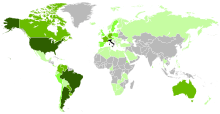
From its unification in 1861 to the Italian economic miracle of the 1950s and 1960s, Italy has been a country of mass emigration. Between 1898 and 1914, the peak years of Italian diaspora, approximately 750,000 Italians emigrated each year.[9] As a consequence, large numbers of people with full or significant Italian ancestry are found in Brazil (32 million Italian Brazilians),[10][11] Argentina (25 million Italian Argentines),[12] United States (18 million Italian Americans),[13] France (5 million Italian French),[14] Venezuela (5 million Italian Venezuelans),[15] Paraguay (2.5 million Italian Paraguayans),[16][17][18] Colombia (2 million Italian Colombians),[19] Uruguay (1.5 million Italian Uruguayans),[20] Peru (1.5 million Italian Peruvians),[21] Canada (1.5 million Italian Canadians),[22] Germany (1.2 million Italian Germans)[23] and Australia (1 million Italian Australians).[24] In addition, Italian communities once thrived in the former African colonies of Eritrea (nearly 100,000 at the beginning of World War II),[25] Somalia and Libya (150,000 Italians settled in Libya, constituting about 18% of the total Libyan population).[26]
After World War II
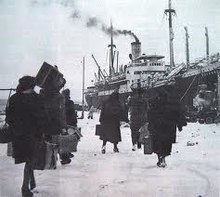
After Tito's annexation of Istria, Kvarner, most of the Julian March as well as the Dalmatian city of Zara following the Treaty of Peace with Italy, 1947, up to 350,000 local ethnic Italians (Istrian Italians and Dalmatian Italians) left communist Yugoslavia (Istrian–Dalmatian exodus).[27][28] Furthermore, all of Libya's Italians were expelled after Muammar Gaddafi's takeover in 1970.[29]
As a result of the profound economic and social changes brought by rapid postwar economic growth, including low birth rates, an aging population and thus a shrinking workforce, by the 1970s emigration had all but stopped and Italy started to have a positive net migration rate.[30] The nation's immigrant population reached 5 million by 2015, making up some 8% of the total population.[31] However, the long-lasting effects of the Eurozone crisis double-dip recession strongly slowed down immigration rates in Italy in the 2010s.[32]
In calendar years 2020 and 2021, as a direct effect of COVID-19 pandemic and Deltacron hybrid variant, Italy registered at least 178,000 excess deaths, a reduction of about 1.4 years in the average life expectancy, a noticeable decrease in birth rates and a marked decrease in immigration rates. Thus there was a record natural population decline of 342,042 units in that[clarification needed] year, the largest ever recorded since 1918 (at the time of World War I and the Spanish flu pandemic).[33] In 2022, Italy's birth rate declined to its lowest level on record since 1861, with fewer then 400,000 births recorded that year.[34][35][36][37][38][39]
Population
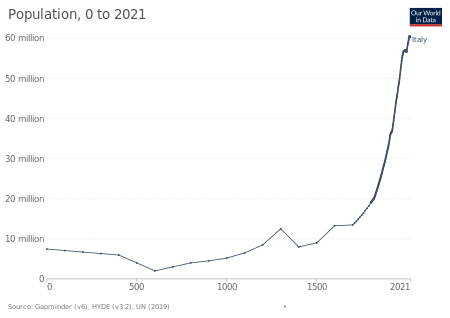
| Year | Pop. | ±% p.a. |
|---|---|---|
| 1861 | 21,777,334 | — |
| 1871 | 26,801,154 | +2.10% |
| 1881 | 28,459,628 | +0.60% |
| 1901 | 32,475,253 | +0.66% |
| 1911 | 34,671,377 | +0.66% |
| 1921 | 37,973,977 | +0.91% |
| 1931 | 41,176,671 | +0.81% |
| 1936 | 42,993,602 | +0.87% |
| 1951 | 47,515,537 | +0.67% |
| 1961 | 50,623,569 | +0.64% |
| 1971 | 54,136,547 | +0.67% |
| 1981 | 56,556,911 | +0.44% |
| 1991 | 56,778,031 | +0.04% |
| 2001 | 56,995,744 | +0.04% |
| 2011 | 59,433,744 | +0.42% |
| 2021 (est.) | 59,257,566 | −0.03% |
| Source: ISTAT[40][41][33] | ||
Demographic statistics according to the World Population Review in 2022.[42]
- One birth every 1 minute 18 seconds
- One death every 50 seconds
- Net loss of one person every 3 minutes 6 seconds
- One net migrant every 9 minutes
Life expectancy
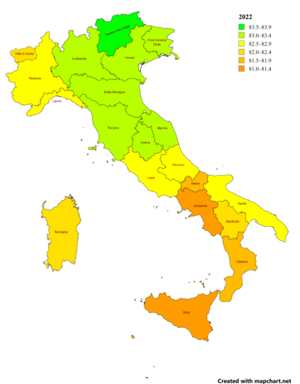
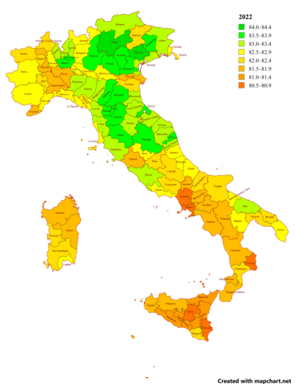
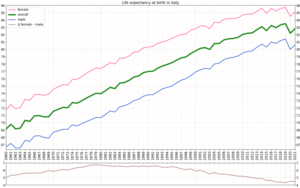
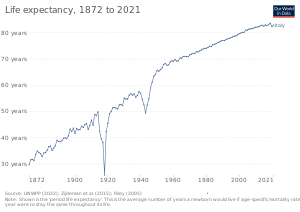
Sources: Our World In Data and the United Nations.1871–1950
| Years | 1871 | 1872 | 1873 | 1874 | 1875 | 1876 | 1877 | 1878 | 1879 | 1880[45] |
|---|---|---|---|---|---|---|---|---|---|---|
| Life expectancy | 29.8 | 29.7 | 31.6 | 31.8 | 31.3 | 33.6 | 34.9 | 34.3 | 34.0 | 32.8 |
| Years | 1881 | 1882 | 1883 | 1884 | 1885 | 1886 | 1887 | 1888 | 1889 | 1890[45] |
| Life expectancy | 34.2 | 34.3 | 35.2 | 36.6 | 36.9 | 35.1 | 36.0 | 37.0 | 39.1 | 38.5 |
| Years | 1891 | 1892 | 1893 | 1894 | 1895 | 1896 | 1897 | 1898 | 1899 | 1900[45] |
| Life expectancy | 38.5 | 38.9 | 39.8 | 40.0 | 39.6 | 40.7 | 43.3 | 42.3 | 43.7 | 41.7 |
| Years | 1901 | 1902 | 1903 | 1904 | 1905 | 1906 | 1907 | 1908 | 1909 | 1910[45] |
| Life expectancy | 43.5 | 43.0 | 43.1 | 44.4 | 43.9 | 45.1 | 45.4 | 43.1 | 44.6 | 46.7 |
| Years | 1911 | 1912 | 1913 | 1914 | 1915 | 1916 | 1917 | 1918 | 1919 | 1920[45] |
| Life expectancy | 44.7 | 48.9 | 48.4 | 49.9 | 42.5 | 39.6 | 38.1 | 25.8 | 42.3 | 45.5 |
| Years | 1921 | 1922 | 1923 | 1924 | 1925 | 1926 | 1927 | 1928 | 1929 | 1930[45] |
| Life expectancy | 49.2 | 50.0 | 51.4 | 51.5 | 51.3 | 50.9 | 52.5 | 52.6 | 52.3 | 55.2 |
| Years | 1931 | 1932 | 1933 | 1934 | 1935 | 1936 | 1937 | 1938 | 1939 | 1940[45] |
| Life expectancy | 54.8 | 54.7 | 56.3 | 56.8 | 56.2 | 56.7 | 55.5 | 56.1 | 57.6 | 57.0 |
| Years | 1941 | 1942 | 1943 | 1944 | 1945 | 1946 | 1947 | 1948 | 1949 | 1950[45] |
| Life expectancy | 54.7 | 52.5 | 49.4 | 52.4 | 54.9 | 59.0 | 61.2 | 63.4 | 64.1 | 65.8 |
1950–2020
| Period | Life expectancy in Years | Period | Life expectancy in Years |
|---|---|---|---|
| 1950–1955 | 66.5 | 1985–1990 | 76.4 |
| 1955–1960 | 68.4 | 1990–1995 | 77.5 |
| 1960–1965 | 69.7 | 1995–2000 | 78.8 |
| 1965–1970 | 70.9 | 2000–2005 | 80.3 |
| 1970–1975 | 72.2 | 2005–2010 | 81.5 |
| 1975–1980 | 73.6 | 2010–2015 | 82.4 |
| 1980–1985 | 74.9 | 2015–2020 | 83.3 |
Source: UN World Population Prospects[46]
Fertility
By 2021, the number of births had fallen to 400,249, a decrease of 25% compared to 2011. If the trend is not reversed, it may adversely affect GDP growth and social security benefits.[47] The reasons that Italian citizens give for not having children are economic costs, fear of losing their job and lack of services for families, but it is claimed that these problems have ceased to exist[dubious ] in other countries such as Sweden and France but that these countries continue to have birth rates below the population replacement level, which is 2.1.[47]
Historical fertility rates
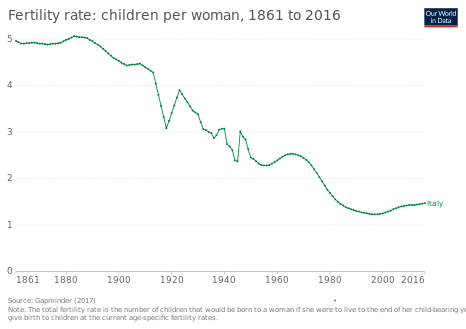
The total fertility rate is the number of children born per woman. This table is based on fairly good data for the entire period. Sources: Our World in Data and Gapminder Foundation.[48]

| Years | 1850 | 1851 | 1852 | 1853 | 1854 | 1855 | 1856 | 1857 | 1858 | 1859 | 1860 |
|---|---|---|---|---|---|---|---|---|---|---|---|
| Rate | 5.47 | 5.42 | 5.38 | 5.33 | 5.29 | 5.24 | 5.19 | 5.15 | 5.10 | 5.06 | 5.01 |
| Years | 1861 | 1862 | 1863 | 1864 | 1865 | 1866 | 1867 | 1868 | 1869 | 1870 | |
| Rate | 4.96 | 4.93 | 4.90 | 4.90 | 4.91 | 4.91 | 4.92 | 4.92 | 4.91 | 4.90 | |
| Years | 1871 | 1872 | 1873 | 1874 | 1875 | 1876 | 1877 | 1878 | 1879 | 1880 | |
| Rate | 4.90 | 4.89 | 4.88 | 4.89 | 4.9 | 4.9 | 4.91 | 4.92 | 4.95 | 4.98 | |
| Years | 1881 | 1882 | 1883 | 1884 | 1885 | 1886 | 1887 | 1888 | 1889 | 1890 | |
| Rate | 5.00 | 5.03 | 5.06 | 5.05 | 5.04 | 5.04 | 5.03 | 5.02 | 4.98 | 4.95 | |
| Years | 1891 | 1892 | 1893 | 1894 | 1895 | 1896 | 1897 | 1898 | 1899 | ||
| Rate | 4.91 | 4.88 | 4.84 | 4.79 | 4.74 | 4.69 | 4.64 | 4.59 | 4.56 |
In 2021 this was 1.47 children born/woman.
Mother's mean age at first birth; 31.1 years (2017 est.)
Age structure
- 0-14 years: 0–14 years: 13.45% (male 4,292,431/female 4,097,732)
- 15-24 years: 9.61% (male 3,005,402/female 2,989,764)
- 25-54 years: 40.86% (male 12,577,764/female 12,921,614)
- 55-64 years: 14% (male 4,243,735/female 4,493,581)
- 65 years and over: 22.08% (male 5,949,560/female 7,831,076) (2020 est.)
Median age
- total: 46.5 years. Country comparison to the world: 5th
- male: 45.4 years
- female: 47.5 years (2020 est.)
Cities
70.4% of Italian population is classified as urban,[49] a relatively low figure among developed countries. Italy's administrative boundaries have seen significant devolution in recent decades; the metropolitan area was created as a new administrative unit, and major cities and metro areas now have a provincial status.
According to OECD,[50] the largest conurbations are:
Urbanization
- urban population: 71% of total population (2020)
- rate of urbanization: 0.29% annual rate of change (2015–20 est.)
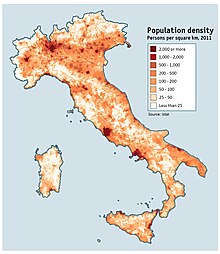
| Metropolitan city | Region | Area (km2) | Population (1 January 2019) | Functional Urban Areas (FUA) Population (2016) |
|---|---|---|---|---|
| Rome | Lazio | 5,352 | 4,342,212 | 4,414,288 |
| Milan | Lombardy | 1,575 | 3,250,315 | 5,111,481 |
| Naples | Campania | 1,171 | 3,084,890 | 3,418,061 |
| Turin | Piedmont | 6,829 | 2,259,523 | 1,769,475 |
| Palermo | Sicily | 5,009 | 1,252,588 | 1,033,226 |
| Bari | Apulia | 3,821 | 1,251,994 | 749,723 |
| Catania | Sicily | 3,574 | 1,107,702 | 658,805 |
| Florence | Tuscany | 3,514 | 1,011,349 | 807,896 |
| Bologna | Emilia-Romagna | 3,702 | 1,014,619 | 775,247 |
| Genoa | Liguria | 1,839 | 841,180 | 713,243 |
| Venice | Veneto | 2,462 | 853,338 | 561,697 |
| Messina | Sicily | 3,266 | 626,876 | 273,680 |
| Reggio Calabria | Calabria | 3,183 | 548,009 | 221,139 |
| Cagliari | Sardinia | 1,248 | 431,038 | 488,954 |
Vital statistics
| Average population (January 1) | Live births | Deaths[59] | Natural change | Crude birth rate (per 1,000) | Crude death rate (per 1,000) | Natural change (per 1,000) | Crude migration change (per 1,000) | Total Fertility Rates[fn 1][48][60] | |
|---|---|---|---|---|---|---|---|---|---|
| 1900 | 32,377,000 | 1,067,376 | 768,917 | 298,459 | 33.0 | 23.7 | 9.2 | -3.9 | 4.53 |
| 1901 | 32,550,000 | 1,057,763 | 715,036 | 342,727 | 32.5 | 22.0 | 10.5 | -3.2 | 4.49 |
| 1902 | 32,787,000 | 1,093,074 | 727,181 | 365,893 | 33.3 | 22.2 | 11.2 | -4.6 | 4.46 |
| 1903 | 33,004,000 | 1,042,090 | 736,311 | 305,779 | 31.6 | 22.3 | 9.3 | -2.2 | 4.43 |
| 1904 | 33,237,000 | 1,085,431 | 698,604 | 386,827 | 32.7 | 21.0 | 11.6 | -4.0 | 4.44 |
| 1905 | 33,489,000 | 1,084,518 | 730,340 | 354,178 | 32.4 | 21.8 | 10.6 | -3.8 | 4.45 |
| 1906 | 33,718,000 | 1,070,978 | 696,875 | 374,103 | 31.8 | 20.7 | 11.1 | -4.2 | 4.45 |
| 1907 | 33,952,000 | 1,062,333 | 700,333 | 362,000 | 31.3 | 20.6 | 10.7 | -3.5 | 4.46 |
| 1908 | 34,198,000 | 1,138,813 | 770,054 | 368,759 | 33.3 | 22.5 | 10.8 | -3.3 | 4.47 |
| 1909 | 34,455,000 | 1,115,831 | 738,460 | 377,371 | 32.4 | 21.4 | 11.0 | -2.4 | 4.43 |
| 1910 | 34,751,000 | 1,144,410 | 682,459 | 461,951 | 32.9 | 19.6 | 13.3 | -5.2 | 4.39 |
| 1911 | 35,033,000 | 1,093,545 | 742,811 | 350,734 | 31.2 | 21.2 | 10.0 | -3.9 | 4.36 |
| 1912 | 35,246,000 | 1,133,985 | 635,788 | 498,197 | 32.2 | 18.0 | 14.1 | -11.1 | 4.32 |
| 1913 | 35,351,000 | 1,122,482 | 663,966 | 458,516 | 31.8 | 18.8 | 13.0 | -3.1 | 4.28 |
| 1914 | 35,701,000 | 1,114,091 | 643,355 | 470,736 | 31.2 | 18.0 | 13.2 | 2.8 | 4.04 |
| 1915 | 36,271,000 | 1,109,183 | 809,703 | 299,480 | 30.6 | 22.3 | 8.3 | -2.5 | 3.80 |
| 1916 | 36,481,000 | 881,626 | 854,703 | 26,923 | 24.2 | 23.4 | 0.7 | -4.5 | 3.56 |
| 1917 | 36,343,000 | 691,207 | 948,710 | -257,503 | 19.6 | 26.1 | -7.1 | -4.5 | 3.32 |
| 1918 | 35,922,000 | 640,263 | 1,268,290 | -628,027 | 18.2 | 35.3 | -17.5 | 11.8 | 3.08 |
| 1919 | 35,717,000 | 770,620 | 676,329 | 94,291 | 21.6 | 18.9 | 2.6 | 4.2 | 3.24 |
| 1920 | 35,960,000 | 1,158,041 | 681,749 | 476,292 | 32.2 | 19.0 | 13.2 | 39.9 | 3.41 |
| 1921 | 37,869,000 | 1,118,344 | 670,234 | 448,110 | 30.7 | 17.7 | 13.0 | -4.4 | 3.57 |
| 1922 | 38,196,000 | 1,127,444 | 690,054 | 437,390 | 30.8 | 18.1 | 12.7 | -2.9 | 3.74 |
| 1923 | 38,571,000 | 1,107,505 | 654,827 | 452,678 | 29.9 | 17.0 | 11.7 | -2.5 | 3.90 |
| 1924 | 38,927,000 | 1,124,470 | 663,077 | 461,393 | 28.9 | 17.0 | 11.9 | -3.2 | 3.81 |
| 1925 | 39,265,000 | 1,109,761 | 669,695 | 440,066 | 28.2 | 17.1 | 11.2 | -2.9 | 3.72 |
| 1926 | 39,590,000 | 1,094,587 | 680,274 | 414,313 | 27.7 | 17.2 | 10.5 | -2.0 | 3.64 |
| 1927 | 39,926,000 | 1,093,772 | 639,843 | 453,929 | 27.4 | 16.0 | 11.4 | -2.5 | 3.55 |
| 1928 | 40,281,000 | 1,072,316 | 645,654 | 426,662 | 26.6 | 16.0 | 10.6 | -2.5 | 3.46 |
| 1929 | 40,607,000 | 1,037,700 | 667,223 | 370,477 | 25.6 | 16.4 | 9.1 | -0.5 | 3.42 |
| 1930 | 40,956,000 | 1,092,678 | 576,751 | 515,927 | 26.7 | 14.1 | 12.6 | -3.2 | 3.38 |
| 1931 | 41,339,000 | 1,026,197 | 609,405 | 416,792 | 24.8 | 14.7 | 10.1 | -4.2 | 3.21 |
| 1932 | 41,584,000 | 990,995 | 610,646 | 380,349 | 23.8 | 14.7 | 9.1 | -0.8 | 3.06 |
| 1933 | 41,928,000 | 995,979 | 574,113 | 421,866 | 23.8 | 13.7 | 10.1 | -1.8 | 3.04 |
| 1934 | 42,277,000 | 992,966 | 563,339 | 429,627 | 23.5 | 13.3 | 10.2 | -1.8 | 3.00 |
| 1935 | 42,631,000 | 996,708 | 594,722 | 401,986 | 23.4 | 14.0 | 9.4 | -1.6 | 2.98 |
| 1936 | 42,965,000 | 962,686 | 593,380 | 369,306 | 22.4 | 13.8 | 8.6 | -1.5 | 2.87 |
| 1937 | 43,269,000 | 991,867 | 618,290 | 373,577 | 22.9 | 14.3 | 8.6 | -1.0 | 2.93 |
| 1938 | 43,596,000 | 1,037,180 | 614,988 | 422,192 | 23.8 | 14.1 | 9.7 | 0 | 3.05 |
| 1939 | 44,018,000 | 1,040,213 | 591,483 | 448,730 | 23.6 | 13.4 | 10.2 | 0 | 3.07 |
| 1940 | 44,467,000 | 1,046,479 | 606,907 | 439,572 | 23.5 | 13.6 | 9.9 | -1.7 | 3.07 |
| 1941 | 44,830,000 | 937,546 | 621,735 | 315,811 | 20.9 | 13.9 | 7.0 | -1.0 | 2.74 |
| 1942 | 45,098,000 | 926,063 | 643,607 | 282,456 | 20.5 | 14.3 | 6.3 | -16.4 | 2.69 |
| 1943 | 44,641,000 | 882,105 | 679,708 | 202,397 | 19.8 | 15.2 | 4.5 | -1.1 | 2.61 |
| 1944 | 44,794,000 | 814,746 | 685,171 | 129,575 | 18.3 | 15.3 | 2.9 | 0.5 | 2.39 |
| 1945 | 44,946,000 | 815,678 | 615,092 | 200,586 | 18.2 | 13.7 | 4.5 | 2.3 | 2.37 |
| 1946 | 45,253,000 | 1,036,098 | 547,952 | 488,146 | 23.0 | 12.1 | 10.8 | -2.2 | 3.01 |
| 1947 | 45,641,000 | 1,011,490 | 524,019 | 487,471 | 22.2 | 11.5 | 10.8 | 5.4 | 2.89 |
| 1948 | 46,381,000 | 1,005,851 | 490,450 | 515,401 | 21.8 | 10.6 | 11.2 | -3.6 | 2.83 |
| 1949 | 46,733,000 | 937,146 | 485,277 | 451,869 | 20.1 | 10.4 | 9.7 | -1.8 | 2.62 |
| 1950 | 47,104,000 | 908,622 | 455,169 | 453,453 | 19.3 | 9.7 | 9.6 | -3.0 | 2.50 |
| 1951 | 47,417,000 | 860,998 | 485,208 | 375,790 | 18.2 | 10.2 | 7.9 | -2.6 | 2.35 |
| 1952 | 47,666,000 [61] | 863,661 | 488,470 | 375,191 | 17.7 | 10.0 | 7.7 | -1.6 | 2.34 |
| 1953 | 47,957,000 | 860,345 | 484,527 | 375,818 | 17.5 | 9.9 | 7.6 | -0.5 | 2.31 |
| 1954 | 48,299,000 | 881,845 | 445,902 | 435,943 | 18.0 | 9.1 | 8.9 | -2.0 | 2.35 |
| 1955 | 48,633,000 | 879,130 | 449,058 | 430,072 | 17.9 | 9.2 | 8.7 | -2.8 | 2.33 |
| 1956 | 48,920,000 | 884,043 | 499,504 | 384,539 | 17.9 | 10.2 | 7.7 | -2.4 | 2.34 |
| 1957 | 49,181,000 | 885,812 | 483,558 | 402.254 | 17.9 | 9.8 | 8.0 | -2.0 | 2.33 |
| 1958 | 49,475,000 | 880,361 | 459,366 | 420,995 | 17.6 | 9.3 | 8.3 | -1.1 | 2.31 |
| 1959 | 49,831,000 | 910,628 | 454,547 | 456,081 | 18.1 | 9.1 | 9.0 | -1.6 | 2.38 |
| 1960 | 50,198,000 | 923,004 | 480,848 | 442,156 | 18.1 | 9.6 | 8.6 | -2.1 | 2.41 |
| 1961 | 50,523,000 | 924,203 | 460,009 | 464,194 | 18.4 | 9.3 | 9.1 | -2.1 | 2.41 |
| 1962 | 50,878,000 | 945,842 | 503,106 | 442,736 | 18.4 | 10.0 | 8.4 | -1.1 | 2.46 |
| 1963 | 51,251,000 | 978,143 | 514,000 | 464,143 | 18.8 | 10.1 | 8.7 | -0.4 | 2.56 |
| 1964 | 51,675,000 | 1,035,207 | 488,601 | 546,606 | 19.7 | 9.5 | 10.2 | -1.7 | 2.70 |
| 1965 | 52,112,000 | 1,017,944 | 516,922 | 501,022 | 19.1 | 10.0 | 9.1 | -1.3 | 2.66 |
| 1966 | 52,518,000 | 999,316 | 493,562 | 505,754 | 18.7 | 9.5 | 9.2 | -1.9 | 2.62 |
| 1967 | 52,900,000 | 962,197 | 507,845 | 454,352 | 18.0 | 9.7 | 8.3 | -2.0 | 2.53 |
| 1968 | 53,235,000 | 944,837 | 530,738 | 414,099 | 17.6 | 10.1 | 7.5 | -1.8 | 2.49 |
| 1969 | 53,538,000 | 949,155 | 530,348 | 418,807 | 17.5 | 10.1 | 7.4 | -2.1 | 2.51 |
| 1970 | 53,821,000 | 917,496 | 528,622 | 388,874 | 16.8 | 9.7 | 7.1 | -2.4 | 2.42 |
| 1971 | 54,073,000 | 911,084 | 515,318 | 395,766 | 16.8 | 9.7 | 7.1 | -1.4 | 2.41 |
| 1972 | 54,381,000 | 893,061 | 518,020 | 375,041 | 16.3 | 9.6 | 6.7 | 0.1 | 2.36 |
| 1973 | 54,751,000 | 887,953 | 544,461 | 343,492 | 16.0 | 10.0 | 6.0 | 0.6 | 2.34 |
| 1974 | 55,111,000 | 886,310 | 532,753 | 353,557 | 15.8 | 9.7 | 6.1 | -0.1 | 2.33 |
| 1975 | 55,441,000 | 841,858 | 556,019 | 285,839 | 14.9 | 10.0 | 4.9 | 0.1 | 2.20 |
| 1976 | 55,718,000 | 806,358 | 556,143 | 250,215 | 14.0 | 9.9 | 4.1 | 0.2 | 2.11 |
| 1977 | 55,955,000 | 757,281 | 547,011 | 210,270 | 13.2 | 9.8 | 3.5 | 0.1 | 1.97 |
| 1978 | 56,155,000 | 720,545 | 539,685 | 180,860 | 12.6 | 9.6 | 3.0 | -0.1 | 1.87 |
| 1979 | 56,318,000 | 682,742 | 541,825 | 140,917 | 11.9 | 9.6 | 2.3 | -0.2 | 1.76 |
| 1980 | 56,434,000 | 657,278 | 559,376 | 97,902 | 11.3 | 9.8 | 1.5 | -0.3 | 1.68 |
| 1981 | 56,502,000 | 628,113 | 540,764 | 87,349 | 11.0 | 9.7 | 1.4 | -0.7 | 1.60 |
| 1982 | 56,544,000 | 634,678 | 537,727 | 96,951 | 10.9 | 9.5 | 1.5 | -1.1 | 1.60 |
| 1983 | 56,564,000 | 612,936 | 563,807 | 49,129 | 10.6 | 10.0 | 0.7 | -0.5 | 1.54 |
| 1984 | 56,577,000 | 597,560 | 535,661 | 61,899 | 10.4 | 9.5 | 0.9 | -0.6 | 1.48 |
| 1985 | 56,593,000 | 589,233 | 549,529 | 39,704 | 10.2 | 9.7 | 0.5 | -0.4 | 1.45 |
| 1986 | 56,596,000 | 562,512 | 545,189 | 17,323 | 9.8 | 9.5 | 0.3 | -0.2 | 1.37 |
| 1987 | 56,602,000 | 560,265 | 534,993 | 25,272 | 9.7 | 9.3 | 0.5 | 0 | 1.35 |
| 1988 | 56,629,000 | 577,856 | 537,545 | 40,311 | 10.1 | 9.5 | 0.5 | 0.3 | 1.38 |
| 1989 | 56,672,000 | 567,268 | 531,557 | 35,711 | 9.9 | 9.4 | 0.5 | 0.3 | 1.35 |
| 1990 | 56,719,000 | 580,761 | 544,397 | 36,364 | 10.0 | 9.6 | 0.5 | 0.2 | 1.36 |
| 1991 | 56,759,000 | 556,175 | 547,131 | 9,044 | 9.9 | 9.8 | 0.2 | 0.5 | 1.32 |
| 1992 | 56,797,000 | 575,216 | 545,038 | 30,178 | 10.0 | 9.6 | 0.4 | 0.2 | 1.32 |
| 1993 | 56,832,000 | 552,587 | 555,043 | -2,456 | 9.7 | 9.7 | -0.1 | 0.3 | 1.26 |
| 1994 | 56,843,000 | 536,665 | 557,513 | -20,848 | 9.4 | 9.8 | -0.4 | 0.4 | 1.22 |
| 1995 | 56,844,000 | 526,064 | 555,203 | -29.139 | 9.2 | 9.8 | -0.5 | 0.8 | 1.19 |
| 1996 | 56,860,000 | 536,740 | 557,756 | -21,016 | 9.3 | 9.8 | -0.5 | 1.0 | 1.22 |
| 1997 | 56,890,000 | 540,048 | 564,679 | -24,631 | 9.4 | 9.9 | -0.5 | 0.8 | 1.23 |
| 1998 | 56,907,000 | 532,843 | 576,911 | -44,068 | 9.3 | 10.1 | -0.8 | 1.0 | 1.21 |
| 1999 | 56,917,000 | 537,242 | 571,356 | -34.114 | 9.4 | 10.0 | -0.5 | 0.9 | 1.23 |
| 2000 | 56,942,000 | 543,039 | 560,241 | -17,202 | 9.5 | 9.8 | -0.3 | 0.9 | 1.26 |
| 2001 | 56,974,000 | 535,282 | 548,254 | -12.972 | 9.4 | 9.8 | -0.4 | 1.9 | 1.25 |
| 2002 | 57,059,000 | 538,198 | 557,393 | -19,195 | 9.4 | 9.8 | -0.4 | 4.9 | 1.27 |
| 2003 | 57,313,000 | 544,063 | 586,468 | -42,405 | 9.5 | 10.3 | -0.7 | 7.2 | 1.29 |
| 2004 | 57,685,000 | 562,599 | 546,658 | 15,941 | 9.8 | 9.5 | 0.3 | 4.6 | 1.34 |
| 2005 | 57,969,000 | 554,022 | 567,304 | -13.282 | 9.5 | 9.8 | -0.2 | 3.2 | 1.33 |
| 2006 | 58,144,000 | 560,010 | 557,892 | 2,118 | 9.6 | 9.6 | 0.0 | 5.1 | 1.37 |
| 2007 | 58,438,000 | 563,933 | 570,801 | -6.868 | 9.6 | 9.8 | -0.2 | 6.9 | 1.39 |
| 2008 | 58,827,000 | 576,659 | 585,126 | -8,467 | 9.8 | 9.9 | -0.1 | 4.7 | 1.44 |
| 2009 | 59,095,000 | 568,857 | 591,663 | -22.806 | 9.6 | 9.8 | -0.3 | 3.4 | 1.44 |
| 2010 | 59,277,000 | 561,944 | 587,488 | -25.544 | 9.4 | 9.7 | -0.3 | 2.0 | 1.44 |
| 2011 | 59,379,000 | 546,585 | 593,402 | -46,817 | 9.1 | 9.9 | -0.8 | 3.5 | 1.44 |
| 2012 | 59,540,000 | 534,186 | 612,883 | -78,697 | 8.9 | 10.2 | -1.3 | 13.0 | 1.42 |
| 2013 | 60,234,000 | 514,308 | 600,744 | -86,436 | 8.5 | 10.0 | -1.4 | 10.6 | 1.39 |
| 2014 | 60,789,000 | 502,596 | 598,364 | -95,768 | 8.3 | 9.9 | -1.6 | 1.7 | 1.38 |
| 2015 | 60,796,000 | 485,780 | 647,571 | -161,791 | 8.1 | 10.7 | -2.7 | 0.6 | 1.36 |
| 2016 | 60,666,000 | 473,438 | 615,261 | -141,823 | 7.9 | 10.2 | -2.4 | 1.0 | 1.36 |
| 2017 | 60,579,000 | 458,151 | 649,061 | -190,910 | 7.6 | 10.8 | -3.2 | 1.6 | 1.34 |
| 2018 | 60,484,000 | 439,747 | 633,133 | -193,386 | 7.3 | 10.6 | -3.2 | -7.8 | 1.31 |
| 2019 | 59,816,673 | 420,084 | 634,417 | -214,333 | 7.0 | 10.6 | -3.6 | 0.7 | 1.27 |
| 2020 | 59,641,488 | 404,892 | 740,317 | -335,425 | 6.8 | 12.4 | -5.6 | -1.2 | 1.24 |
| 2021 | 59,236,213 | 400,249 | 701,346 | -301,097 | 6.8 | 11.8 | -5.2 | 1.7 | 1.25 |
| 2022 | 59,030,133 | 393,333 | 715,077 | -321,744 | 6.8 | 12.1 | -5.4 | 4.8 | 1.24 |
| 2023 | 58,997,201 | 379,339 | 660,600 | -281.267 | 6.4 | 11.2 | -4.8 | 4.7 | 1.22 |
| 2024 | 58,989,749 |
In the year 2022 82,216 babies were born to at least one foreign parent which makes up 20.9% of all newborns in that year (20,274 or 5.15% were born to foreign fathers, 8,863 or 2.25% to foreign mothers and 53,079 or 13.49% to two foreign parents). In Southern Italy (including Sicily and Sardinia) only 8.8 percent of all newborns had 1 or 2 foreign parents, whereas in Central and Northern Italy their share reached 23.0 and 29.6 percent, respectively.[62]
Current vital statistics
| Period | Live births | Deaths | Natural increase |
|---|---|---|---|
| January 2023 | 33,287 | 67,132 | -33,845 |
| January 2024 | 31,861 | 64,769 | -32,908 |
| Difference |  -1,426 (-4.28%) -1,426 (-4.28%) |  -2,363 (-3.52%) -2,363 (-3.52%) |  +937 +937 |
Structure of the population
| Age Group | Male | Female | Total | % |
|---|---|---|---|---|
| Total | 28 866 226 | 30 369 987 | 59 236 213 | 100 |
| 0–4 | 1 138 845 | 1 077 665 | 2 216 510 | 3.74 |
| 5–9 | 1 326 061 | 1 252 279 | 2 578 340 | 4.35 |
| 10–14 | 1 463 873 | 1 377 822 | 2 841 695 | 4.80 |
| 15–19 | 1 476 815 | 1 380 198 | 2 857 013 | 4.82 |
| 20–24 | 1 549 500 | 1 407 840 | 2 957 340 | 4.99 |
| 25–29 | 1 566 265 | 1 479 314 | 3 045 579 | 5.14 |
| 30–34 | 1 633 887 | 1 592 259 | 3 226 146 | 5.45 |
| 35–39 | 1 747 529 | 1 735 723 | 3 483 252 | 5.88 |
| 40–44 | 2 001 502 | 2 007 068 | 4 008 570 | 6.77 |
| 45–49 | 2 329 457 | 2 363 044 | 4 692 501 | 7.92 |
| 50–54 | 2 377 041 | 2 440 634 | 4 817 675 | 8.13 |
| 55–59 | 2 261 108 | 2 362 857 | 4 623 965 | 7.81 |
| 60–64 | 1 901 209 | 2 044 887 | 3 946 096 | 6.66 |
| 65-69 | 1 652 948 | 1 821 385 | 3 474 333 | 5.87 |
| 70-74 | 1 609 510 | 1 831 661 | 3 441 171 | 5.81 |
| 75-79 | 1 140 634 | 1 406 576 | 2 547 210 | 4.30 |
| 80-84 | 953 118 | 1 324 845 | 2 277 963 | 3.85 |
| 85-89 | 513 213 | 882 889 | 1 396 102 | 2.36 |
| 90-94 | 186 194 | 443 464 | 629 658 | 1.06 |
| 95-99 | 34 670 | 123 247 | 157 917 | 0.27 |
| 100-104 | 2 728 | 13 404 | 16 132 | 0.03 |
| 105-109 | 117 | 907 | 1 024 | <0.01 |
| 110+ | 2 | 19 | 21 | <0.01 |
| Age group | Male | Female | Total | Percent |
| 0–14 | 3 928 779 | 3 707 766 | 7 636 545 | 12.89 |
| 15–64 | 18 844 313 | 18 813 824 | 37 658 137 | 63.57 |
| 65+ | 6 093 134 | 7 848 397 | 13 941 531 | 23.54 |
Health
Obesity – adult prevalence rate
- 19.9% (2016) Country comparison to the world: 108
Employment and income
Unemployment, youth ages 15–24:
- total: 32.2%. Country comparison to the world: 26th
- male: 30.4%
- female: 34.8% (2018 est.)
Immigration
Since the fall of the Berlin Wall in 1989, and more recently, the 2004 and 2007 enlargements of the European Union, Italy received growing flows of migrants from the former socialist countries of Eastern Europe (especially Romania, Albania, Ukraine and Poland).[64] The second most important area of immigration to Italy has always been the neighboring North Africa (especially Morocco, Egypt, Tunisia and Algeria).[65] Furthermore, in recent years, growing migration fluxes from the Far East (notably, China[66] and the Philippines) and Latin America (Ecuador, Peru) have been recorded.
Italy does not collect data on ethnicity or race of the country, but does collect data on nationality of its residents.[67]
In 2021, Istat estimated that 5,171,894 foreign citizens lived in Italy, representing about 8.7% of the total population.[33] These figures do not include naturalized foreign-born residents (121,457 foreigners acquired Italian citizenship in 2021)[68] as well as illegal immigrants, the so-called clandestini, whose numbers, difficult to determine, are thought to be at least 670,000.[69] Romanians made up the largest community in the country (1,145,718; around 10% of them being ethnic Romani people[70]), followed by Albanians (441,027) and Moroccans (422,980).[71][72]
The fourth largest community of foreign residents in Italy was represented by the Chinese.[73] The majority of Chinese living in Italy are from the city of Wenzhou in the province of Zhejiang.[74] Breaking down the foreign-born population by continent, in 2020 the figures were as follows: Europe (54%), Africa (22%), Asia (16%), the Americas (8%) and Oceania (0.06%). The distribution of immigrants is largely uneven in Italy: 83% of immigrants live in the northern and central parts of the country (the most economically developed areas), while only 17% live in the southern half of the peninsula.[75]
- Net migration rate
- 3.21 migrant(s)/1,000 population (2021 est.) Country comparison to the world: 34th
| Nationality groups | Year | |||||||||||||
|---|---|---|---|---|---|---|---|---|---|---|---|---|---|---|
| 2002[76] | 2005[76] | 2010[76] | 2015[76] | 2019[77] | 2021[78] | 2023[79] | ||||||||
| Number | % | Number | % | Number | % | Number | % | Number | % | Number | % | Number | % | |
 Italians Italians | 55,651,856 | 97.64% | 55,775,350 | 96.09% | 55,853,967 | 93.57% | 55,460,252 | 91.98% | 54,820,515 | 91.65% | 54,064,319 | 91.27% | 53,855,860 | 91.29% |
| Foreigners | 1,341,414 | 2.36% | 2,269,018 | 3.91% | 3,836,349 | 6.43% | 4,835,245 | 8.02% | 4,996,158 | 8.35% | 5,171,894 | 8.73% | 5,141,341 | 8.71% |
 EU-27 EU-27 | – | – | – | – | – | – | – | – | 1,472,847 | 2.46% | 1,406,623 | 2.47% | 1,393,782 | 2.36% |
| Other European | – | – | – | – | – | – | – | – | 1,036,761 | 1.73% | 1,053,765 | 1.78% | 1,024,029 | 1.74% |
| Northern Africa | – | – | – | – | – | – | – | – | 639,994 | 1.07% | 689,649 | 1.16% | 689,083 | 1.17% |
| Central and South Asia | – | – | – | – | – | – | – | – | 528,182 | 0.88% | 605,000 | 1.02% | 619,671 | 1.05% |
| Eastern Asia | – | – | – | – | – | – | – | – | 464,557 | 0.78% | 521,686 | 0.88% | 489,804 | 0.83% |
| Western Africa | – | – | – | – | – | – | – | – | 389,602 | 0.65% | 400,112 | 0.68% | 401,218 | 0.68% |
| Central and South America | – | – | – | – | – | – | – | – | 345,466 | 0.58% | 366,062 | 0.62% | 370,415 | 0.63% |
| Western Asia | – | – | – | – | – | – | – | – | 36,914 | – | 44,272 | – | 71,761 | – |
| Eastern Africa | – | – | – | – | – | – | – | – | 37,131 | – | 35,486 | – | 35,833 | – |
| Central and South Africa | – | – | – | – | – | – | – | – | 24,919 | – | 25,343 | – | 25,299 | – |
| Northern America | – | – | – | – | – | – | – | – | 17,082 | – | 21,216 | – | 17,812 | – |
| Oceania | – | – | – | – | – | – | – | – | 2,120 | – | 2,248 | – | 1,991 | – |
| Stateless | – | – | – | – | – | – | – | – | 583 | – | 432 | – | 643 | – |
| Total | 56,993,270 | 100% | 58,044,368 | 100% | 59,690,316 | 100% | 60,295,497 | 100% | 59,816,673 | 100% | 59,236,213 | 100% | 58,997,201 | 100% |
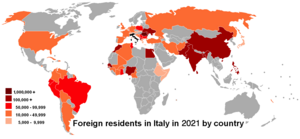
| Year | Population |
|---|---|
| 2002 | 1,341,209[80] |
| 2003 | 1,464,663[80] |
| 2004 | 1,854,748[80] |
| 2005 | 2,210,478[80] |
| 2006 | 2,419,483[80] |
| 2007 | 2,592,950[80] |
| 2008 | 3,023,317[80] |
| 2009 | 3,402,435[80] |
| 2010 | 3,648,128[80] |
| 2011 | 3,879,224[80] |
| 2012 | 4,052,081[81] |
| 2013 | 4,387,721[82] |
| 2014 | 4,922,085[83] |
| 2015 | 5,014,437[84] |
| 2016 | 5,026,153[85] |
| 2017 | 5,047,028[86] |
| 2018 | 5,144,440[87] |
| 2019 | 5,255,503[88] |
| 2020 | 5,013,215[89] |
| 2021 | 5,171,894 (8.7%)[90] |
There are, as of 2022, 5,030,716 Foreign-born residents, accounting for 8.5% of the total population.
Their distribution by country of origin was as follows:
| Country | Population[91] |
|---|---|
  Romania Romania | 1,081,836 |
 Albania Albania | 416,829 |
 Morocco Morocco | 415,088 |
 China China | 307,038 |
 Ukraine Ukraine | 249,613 |
 Bangladesh Bangladesh | 174,058 |
 India India | 167,333 |
 Philippines Philippines | 158,926 |
 Egypt Egypt | 147,797 |
 Pakistan Pakistan | 144,129 |
 Nigeria Nigeria | 123,646 |
 Senegal Senegal | 112,598 |
 Sri Lanka Sri Lanka | 109,828 |
 Moldova Moldova | 109,804 |
 Tunisia Tunisia | 102,422 |
 Peru Peru | 98,733 |
  Poland Poland | 74,387 |
 Ecuador Ecuador | 63,211 |
 Brazil Brazil | 51,125 |
 North Macedonia North Macedonia | 51,090 |
  Bulgaria Bulgaria | 49,518 |
 Ghana Ghana | 47,335 |
 Russia Russia | 39,705 |
 Kosovo Kosovo | 36,372 |
  Germany Germany | 34,003 |
 Serbia Serbia | 30,835 |
  France France | 29,942 |
 Dominican Republic Dominican Republic | 29,571 |
 Georgia Georgia | 29,222 |
 Ivory Coast Ivory Coast | 28,559 |
  Spain Spain | 27,854 |
 United Kingdom United Kingdom | 27,758 |
 Cuba Cuba | 23,351 |
 El Salvador El Salvador | 22,693 |
 Gambia Gambia | 22,637 |
 Mali Mali | 21,032 |
 Colombia Colombia | 20,856 |
 Bosnia and Herzegovina Bosnia and Herzegovina | 20,454 |
Languages
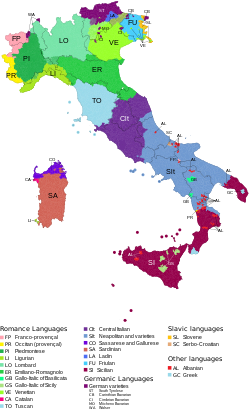
Italy's official language is Italian; Ethnologue has estimated that there are about 55 million speakers of Italian in the country and a further 6.7 million outside of it, primarily in the neighboring countries and in the Italian diaspora worldwide.[92] Italian, adopted by the central state after the unification of Italy, is a language based on the Florentine variety of Tuscan and is somewhat intermediate between the Italo-Dalmatian languages and the Gallo-Romance languages. Its development was also influenced by the Germanic languages of the post-Roman invaders. When Italy unified in 1861, only 3% of the population spoke Italian,[93] even though an estimated 90% of Italians speak Italian as their L1 nowadays.[94]
Italy is in fact one of the most linguistically diverse countries in Europe,[95] as there are not only varieties of Italian specific to each cultural region, but also distinct regional and minority languages. The establishment of the national education system has led to the emergence of the former and a decrease in the use of the latter. The spread of Italian was further expanded in the 1950s and 1960s, because of the economic growth and the rise of mass media and television, with the state broadcaster (RAI) setting a colloquial variety of Italian to which the population would be exposed.
As a way to distance itself from the Italianization policies promoted because of nationalism, Italy recognized twelve languages as the Country's "historical linguistic minorities",[96] which are promoted alongside Italian in their respective territories. French is co-official in the Aosta Valley as the province's prestige variety, under which the more commonly spoken Franco-Provencal dialects have been historically roofed.[97] German has the same status in the province of South Tyrol as, in some parts of that province and in parts of the neighbouring Trentino, does Ladin.[98] Slovene[99] and Friulian are officially recognised in the provinces of Trieste, Gorizia and Udine in Venezia Giulia. In Sardinia, the Sardinian language has been the language traditionally spoken and is often regarded by linguists as constituting its own branch of Romance;[100] in the 1990s, Sardinian has been recognized as "having equal dignity" with Italian,[101] the introduction of which to the island officially started under the rule of the House of Savoy in the 18th century.
In these regions, official documents are either bilingual (trilingual in Ladin communities) in the co-official language(s) by default, or available as such upon request. Traffic signs are also multilingual, except in the Valle d'Aosta where French toponyms are generally used, with the exception of Aosta itself, which has retained its Latin form in Italian as well as English. Attempts to Italianize them, especially during the Fascist period, have been formally abandoned. Education is possible in minority languages where such schools are operating.
UNESCO and other authorities recognize a number of other languages which are not legally protected by Italian government: Piedmontese, Venetian, Ligurian, Lombard, Emilian-Romagnolo, Neapolitan and Sicilian.
Religion
Religion in Italy according to the Eurobarometer survey, 2021[102]
Roman Catholicism is by far the largest religion in the country, although the Catholic Church is no longer officially the state religion. In 2006, 87.8% of Italy's population self-identified as Roman Catholic,[103] although only about one-third of these described themselves as active members (36.8%). In 2016, 71.1% of Italian citizens self-identified as Roman Catholic.[104] This increased again to 78% in 2018.[8]
Most Italians believe in God, or a form of a spiritual life force. According to a Eurobarometer Poll in 2005:[105] 74% of Italian citizens responded that 'they believe there is a God', 16% answered that 'they believe there is some sort of spirit or life force' and 6% answered that 'they do not believe there is any sort of spirit, God, or life force'. There are no data collected through census.
Christianity
The Italian Catholic Church is part of the global Roman Catholic Church, under the leadership of the Pope, curia in Rome, and the Conference of Italian Bishops. In addition to Italy, two other sovereign nations are included in Italian-based dioceses, San Marino and Vatican City. There are 225 dioceses in the Italian Catholic Church, see further in this article and in the article List of the Roman Catholic dioceses in Italy. Even though by law Vatican City is not part of Italy, it is in Rome, and along with Latin, Italian is the most spoken and second language of the Roman Curia.[106]
Italy has a rich Catholic culture, especially as numerous Catholic saints, martyrs and popes were Italian themselves. Roman Catholic art in Italy especially flourished during the Middle Ages, Renaissance and Baroque periods, with numerous Italian artists, such as Michelangelo, Leonardo da Vinci, Raphael, Caravaggio, Fra Angelico, Gian Lorenzo Bernini, Sandro Botticelli, Tintoretto, Titian and Giotto. Roman Catholic architecture in Italy is equally as rich and impressive, with churches, basilicas and cathedrals such as St Peter's Basilica, Florence Cathedral and St Mark's Basilica. Roman Catholicism is the largest religion and denomination in Italy, with around 71.1% of Italians considering themselves Catholic. Italy is also home to the greatest number of cardinals in the world,[107] and is the country with the greatest number of Roman Catholic churches per capita.[108]

Even though the main Christian denomination in Italy is Roman Catholicism, there are some minorities of Protestant, Waldensian, Eastern Orthodox and other Christian churches.
Immigration from Western, Central, and Eastern Africa at the beginning of the 21st century has increased the size of Baptist, Anglican, Pentecostal and Evangelical communities in Italy, while immigration from Eastern Europe has produced large Eastern Orthodox communities.
In 2006, Protestants made up 2.1% of Italy's population, and members of Eastern Orthodox churches comprised 1.2% or more than 700,000 Eastern Orthodox Christians including 180,000 Greek Orthodox,[111] 550,000 Pentecostals and Evangelists (0.8%), of whom 400,000 are members of the Assemblies of God, about 250,000 are Jehovah's Witnesses (0.4%),[112] 30,000 Waldensians,[113] 25,000 Seventh-day Adventists, 22,000 Mormons, 15,000 Baptists (plus some 5,000 Free Baptists), 7,000 Lutherans, 4,000 Methodists (affiliated with the Waldensian Church).[114]
Other religions
The longest-established religious faith in Italy is Judaism, Jews having been present in Ancient Rome before the birth of Christ. Italy has seen many influential Italian-Jews, such as prime minister Luigi Luzzatti, who took office in 1910, Ernesto Nathan served as mayor of Rome from 1907 to 1913 and Shabbethai Donnolo (died 982). During the Holocaust, Italy took in many Jewish refugees from Nazi Germany. However, with the creation of the Nazi-backed puppet Italian Social Republic, about 15% of 48,000 Italian Jews were killed. This, together with the emigration that preceded and followed the Second World War, has left only a small community of around 45,000 Jews in Italy today.
Due to immigration from around the world, there has been an increase in non-Christian religions. As of 2009, there were 1.0 million Muslims in Italy[115] forming 1.6 percent of population; independent estimates put the Islamic population in Italy anywhere from 0.8 million[116] to 1.5 million.[117] 50,000 Italian Muslims hold Italian citizenship.
There are more than 200,000 followers of faiths originating in the Indian subcontinent, including some 70,000 Sikhs with 22 gurdwaras across the country,[118] 70,000 Hindus, and 50,000 Buddhists.[119] There were an estimated 4,900 Bahá'ís in Italy in 2005.[120]
Education
Literacy
- definition: age 15 and over can read and write
- total population: 99.2%
- male: 99.4%
- female: 99% (2018 est.)
School life expectancy (primary to tertiary education)
- total: 16 years
- male: 16 years
- female: 17 years (2018)
Genetics and ethnic groups
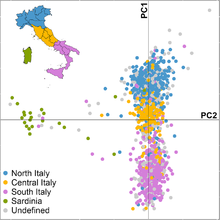
The genetic history of Italy is greatly influenced by geography and history. The ancestors of Italians are mostly Indo-European speakers (Italic peoples such as Latins, Umbrians, Samnites, Oscans, Sicels and Adriatic Veneti, as well as Celts, Iapygians and Greeks) and pre-Indo-European speakers (Etruscans, Ligures, Rhaetians and Camunni in mainland Italy, Sicani and Elymians in Sicily and the Nuragic people in Sardinia). During the imperial period of Ancient Rome, the city of Rome was also home to people from various regions throughout the Mediterranean basin, including Southern Europe, North Africa and the Middle East.[122] Based on DNA analysis, there is evidence of ancient regional genetic substructure and continuity within modern Italy dating to the pre-Roman and Roman periods.[123][124][125][126]
Within the Italian population, there is enough cultural, linguistic, genetic and historical diversity for them to constitute several distinct groups throughout the peninsula.[127] In this regard, peoples like the Friulians, the Ladins, the Sardinians and the South Tyroleans, who also happen to constitute recognized linguistic minorities, or even the Sicilians who are not, are cases in point, attesting to such internal diversity.
Linguistic minorities in Italy include Sardu-speakers 1 million, Tyrolese German-speakers 350,000, Albanians 70,000 – 100,000, Slovenes 60,000, Franco-Provençal-speakers 50,000 – 70,000, Occitans 20,000 – 40,000, Ladins 30,000, Catalans 15,000, Greek-speakers 12,000, Croatians 3,000 and Friulians 600,000. The Roma community is one of the largest ethnic minorities in Italy. Due to the lack of disaggregated data the size of the Italian Roma community remains unknown. The Council of Europe estimates that between 120,000 and 180,000 Roma live in Italy. A significant proportion of Roma in Italy do not have Italian citizenship.[128]
See also
Footnotes
References
External links

- Demographic page Archived 22 June 2017 at the Wayback Machine
- Demographic Profile Italy Allianz Knowledge
